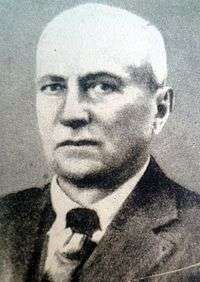Petro Poga
| Petro Vito Poga | |
|---|---|
 | |
| Born |
1850 Erind, Ottoman Empire |
| Died |
1944 Erind, Albania |
| Nationality | Albanian |
| Known for |
"Drita" magazine Central Committee for Defending Albanian Rights Society for the Publication of Albanian Writings Albanian Declaration of Independence Congress of Durrës |
Petro Poga (1850–1944) was one of the delegates of Albanian Declaration of Independence event in Vlorë, 1912,[1] and one of the most important Albanian Rilindas.
He was born in Erind, Gjirokastër, Albania (then Ottoman Empire), son of Vito Poga, a local who had previously worked in his region and in Istambul as a tailor.[2]
Poga went to the Zosimea Greek language School of Ioannina, Greece (then Ottoman Empire) and then graduated in Jurisprudence from the Istanbul University. In Istanbul he was active part of the Central Committee for Defending Albanian Rights, and the Society for the Publication of Albanian Writings. These two associations, both founded by Sami Frashëri, included Naim Frashëri, Abdyl Frashëri, Jani Vreto, Koto Hoxhi, Shahin Kolonja, Hasan Tahsini, and Ismail Qemali and aimed to create an independent Albania.
In 1884 Poga founded and started publishing the Drita in Istambul.[3] As Muslim Albanians were not allowed to write in Albanian at that time, Albanian writers such as Naim Frasheri and Sami Frasheri would write using pseudonyms.[4] Shahin Kolonja would take over after him. The magazine was later published by Pandeli Sotiri, under the name of Dituria ("Knowledge" in English).
In his memories Petro Poga wrote:
The magazine Drita awakened the sacred national ideal and influenced to establish in the Albanians' hearts the thought that religions can not change a nation, because they cannot change the language and customs that create a nation.
In 1906-1908, Petro Poga was in Gjirokastër where he contributed with the propagation of the Albanian language and the Albanian identity. One of his most important roles was the foundation of the patriotic club "Drita" of Gjirokastër, which was further led by Albanian patriots Hasan Xhiku, Idriz Guri, Hysen Hoxha, and Elmaz Boçe.
Petro Poga strongly advocated for the Albanian move towards independence in 1912. He was elected as one of the representatives of Gjirokastër to the National Assembly of Vlora which declared Albania's independence from the Ottoman Empire.
After Albania's independence in 1912 he was a Minister of Justice in the first Albanian government and acted twice as a Prime Minister of Albania (1 February 1925 - 23 September 1925 and 12 February 1927 - 20 October 1927).
Poga became the President of the Supreme Court of Albania in 1913-1915. Along with Dhimitër Tutulani and Feim Mezhgorani he drafted the Statute that separated the Albanian Justice system from the jurisdiction of the Ottoman Empire. On December 25, 1918 he was the representative of Gjirokastër in the Congress of Durrës, where he was elected vicepresident and member of the Turhan Përmeti cabinet. Along with Luigj Gurakuqi in his discussions in this Congress he asked to adopt a law to respect religious freedoms according to European standards of that time. He also gave his contribution to draft the Albanian legislation and the Constitution of the Albanian Kingdom in 1928.
Poga spent his last years in his childhood village in Erind.
References
"History of Albanian People" Albanian Academy of Science.ISBN 99927-1-623-1
- ↑ Michael Schmidt-Neke (1987-11-16), Entstehung und Ausbau der Königsdiktatur in Albanien (1912-1939): Regierungsbildungen, Herrschaftsweise und Machteliten in einem jungen Balkanstaat, Oldenbourg Wissenschaftsverlag, p. 320, ISBN 978-3486543216
- ↑ Kleanthi Dedi (2012-12-10), Petro Poga, ministri i parë i Drejtësisë në qeverinë e Ismail Qemalit [Petro Poga, first Minister of Justice in Ismail Qemali's cabinet] (in Albanian), Gazeta Telegrafi, retrieved 2014-01-17
- ↑ Skendi, Stavro (1967). The Albanian national awakening, 1878-1912. Princeton University Press. p. 146.
- ↑ The crescent and the eagle: Ottoman rule, Islam and the Albanians, 1874-1913 By George Walter Gawrych page 88